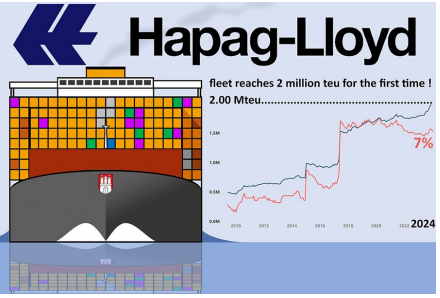Hapag-Lloyd Hits 2 Million TEU in Vessel Fleet Capacity for the First Time
Hapag-Lloyd achieved a significant milestone last week as its operated fleet capacity exceeded 2.00 million TEU for the first time in its history. As of February 21, the Hamburg-based shipping liner deployed a fleet consisting of 273 ships with a combined nominal intake of 2,000,520 TEU.
This accomplishment positions Hapag-Lloyd as the fifth-largest global liner carrier, with a capacity of approximately 1.00 million TEU behind COSCO Group (3.09 million TEU) and ahead of Ocean Network Express by around 200,000 TEU (1.81 million TEU).
Hapag-Lloyd’s fleet is comprised of 122 owned ships with a capacity of 1.19 million TEU and 151 chartered units with a combined intake of 0.81 million TEU. The carrier’s newbuilding pipeline is relatively modest, with only eleven ships and 239,500 TEU, constituting 12% of its fleet capacity. In addition to new ships, Hapag-Lloyd has forward-fixed several large neo-panamax vessels that are yet to join the carrier.
Some of these ships are scheduled for significant capacity upgrades and scrubber retrofits before commencing their charters with Hapag-Lloyd. Currently, 32% of the carrier’s fleet capacity is scrubber-fitted, and a series of twelve LNG-powered megamaxes is being delivered to Hapag-Lloyd.
Hapag-Lloyd’s fleet experienced substantial growth, jumping from 0.74 million TEU to 0.98 million TEU in January 2015 after merging with CSAV. The mid-2017 merger with UASC further boosted the fleet from 1.06 million TEU to 1.53 million TEU. Since then, the fleet has primarily expanded through organic growth, including newbuilding initiatives, second-hand acquisitions, and chartering. Niche acquisitions, such as Niledutch (2021) and Deutsche Afrika-Linien (2022), had only a minor impact on Hapag-Lloyd’s operated fleet.

